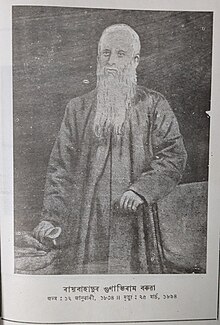Gunabhiram Barua
Gunabhiram Barua | |
|---|---|
 | |
| Born | 1834 |
| Died | 1894 (aged 59–60) |
| Occupation | Dramatist, historian, essayist, social reformer |
| Language | Assamese |
| Nationality | Indian |
| Spouse | Bishnupriya Devi |
| Children | Swarnalata Devi Karunabhiram Barua Jnanabhiram Barua |
Gunabhiram Barua (1834-1894) was a nineteenth century Indian intellectual from Assam who ushered in new ideas of social reform in the early years of colonial rule in Assam.[1] He was deeply influenced by the progressive intellectual currents of the Bengal Renaissance. He was among the few Assamese publicists who had formally entered the Brahmo Samaj. All his life he propagated its liberal ideas through his writings.
Biography
[edit]Barua completed his college education from Presidency College, Calcutta and became an assistant commissioner under the colonial government. He remained in the job for the next 30 years.[2]
After his first wife's death, his 1879 marriage with a Brahman widow, Bishnupriya Devi, created a sensation in the orthodox society of Assam. Bishnupriya and their daughter Swarnalata Barua[3] were encouraged by him to write and publish their work in magazines and newspapers.[2]
Barua advocated the cause of women's education and took the bold step of sending his daughter Swarnalata Devi to a boarding school in Calcutta when he was working in the small town of Nagaon in Assam as an Extra Assistant Commissioner.[2]
His son Jnanadabhiram Barua went on to become a well-known lawyer and leader of the Indian National Congress. Gunabhiram wrote a number of tracts for children, published under the heading Lara Bandhu (Friend of Boys) in Arunodoi, the first Assamese newspaper, published by American missionaries. Lara Bondhu was also named as the first children's magazine in Assamese literature edited by his son Karunabhiram Barua.[4]
Gunabhiram Barua was a cousin of Anandaram Dhekial Phukan. In fact, Gunabhiram grew up under Anandaram's tutelage, as his parents died when he was a child.[1]
Literary works
[edit]The first social drama in Assamese – Ramnabami-Natak – was written by Gunabhiram in 1857 and published as a book in 1870.[5] The play tells the tragic story of a young widow, Nabami, and her lover, Ram, both of whom were compelled to commit suicide because of social disapproval of their relationship.[6][7]
Gunabhiram is also remembered as a historian and biographer. In 1887 he published an Assam Buranji, which went on to become a school textbook. He also wrote regularly on issues such as women's education and marriage reforms.[2] Kathin Shobdor Rohasyha Bakhya is a humorous work by Barua, published posthumously in 1912. .[8]
Gunabhiram Barua published and edited the short-lived but hugely influential literary journal Assam-Bandhu(1885-1886).[9] Famous conservative intellectuals such as Ratneshwar Mahanta and Rudraram Doloi also contributed to its pages.[6]
Trivia
[edit]Hindi film actor Sharmila Tagore is the granddaughter of Gunabhiram's son Jnanadabhiram on her maternal side.
See also
[edit]- History of Assamese literature
- List of Asam Sahitya Sabha presidents
- List of Assamese-language poets
- List of Assamese writers with their pen names
References
[edit]- ^ a b Sharma, Jayeeta (August 2011). Empire's Garden: Assam and the Making of India - Jayeeta Sharma - Google Books. ISBN 978-0822350491. Retrieved 22 June 2013.
- ^ a b c d "Gunabhiram Barua - Pioneers of modern Assamese literature and language". Onlinesivasagar.com. Retrieved 22 June 2013.
- ^ Das, Sisir Kumar (2005). A History of Indian Literature 1911-1956: Struggle for Freedom: Triumph and ... - Sisir Kumar Das - Google Books. ISBN 9788172017989. Retrieved 22 June 2013.
- ^ Datta, Amaresh (1987). Encyclopaedia of Indian Literature: A-Devo - Google Books. ISBN 9788126018031. Retrieved 22 June 2013.
- ^ Baruwā, Guṇābhirāma (2007). Ramnabami-Natak: the story of Ram and Nabami - Gunabhiram Barua, Guṇābhirāma Baruwā, Tilottoma Misra - Google Books. ISBN 9780195685947. Retrieved 22 June 2013.
- ^ a b Natarajan, Nalini; Nelson, Emmanuel Sampath (1996). Handbook of Twentieth-Century Literatures of India - Google Books. ISBN 9780313287787. Retrieved 22 June 2013.
- ^ vnh - Google Books. Retrieved 22 June 2013.
- ^ Misra, Sanghamitra (3 April 2013). Becoming a Borderland: The Politics of Space and Identity in Colonial ... - Sanghamitra Misra - Google Books. ISBN 9781136197215. Retrieved 22 June 2013.
- ^ enajori.com. "Asam Bandhu, First issue (1885), Editor: Gunabhiram Barua". enajori.com. Archived from the original on 24 June 2013. Retrieved 22 June 2013.
- 1837 births
- 1894 deaths
- Dramatists and playwrights from Assam
- People from Kamrup Metropolitan district
- 19th-century Indian dramatists and playwrights
- Indian male writers
- Presidency University, Kolkata alumni
- 19th-century Indian male writers
- 19th-century Indian essayists
- 19th-century Indian historians
- Scholars from Assam
